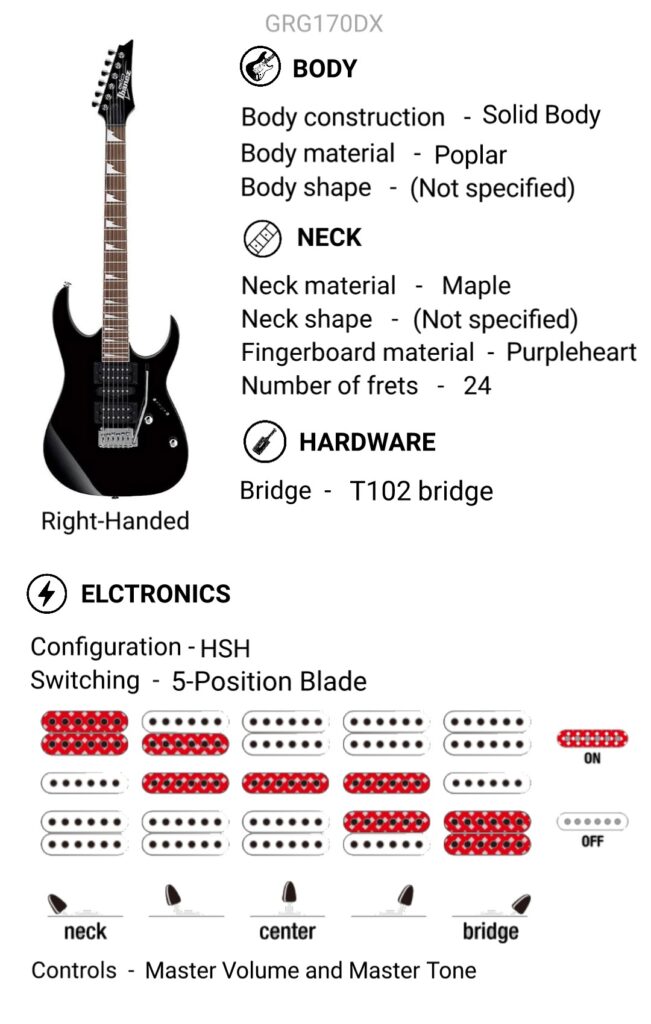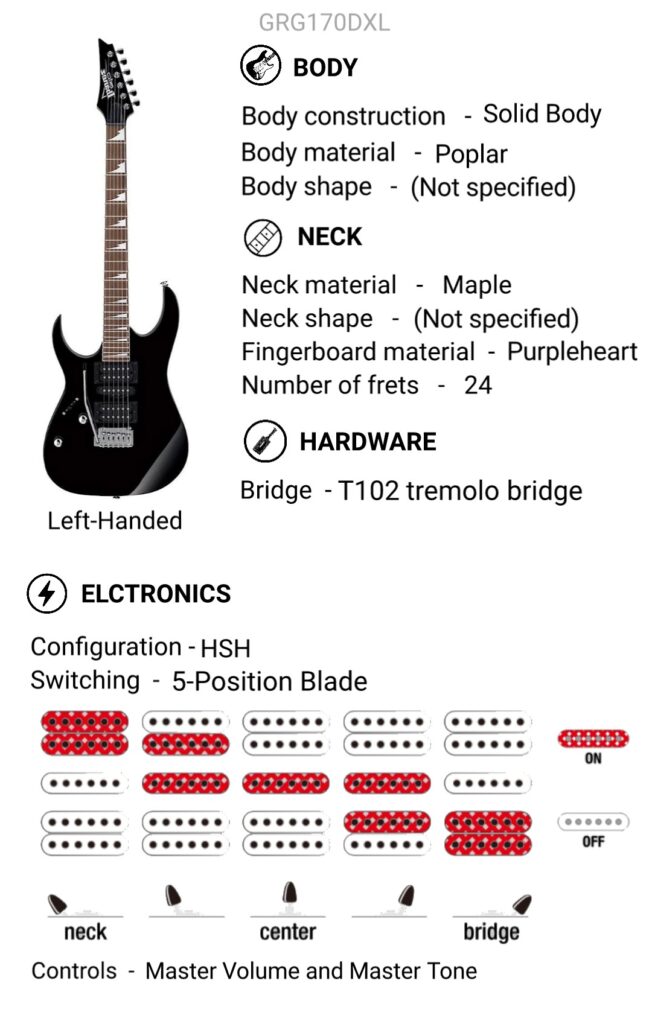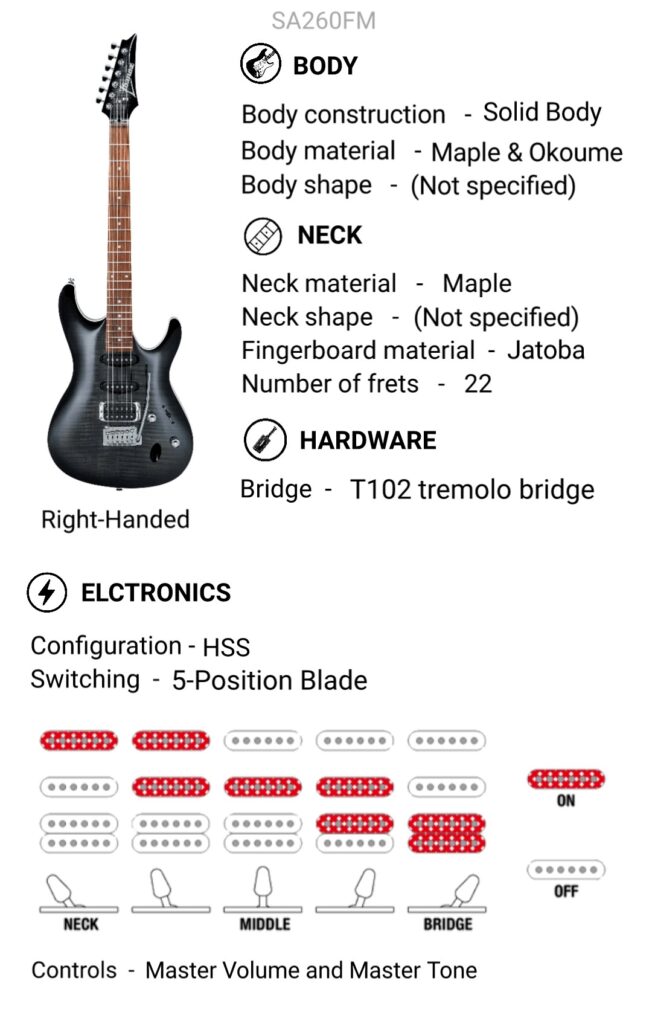list of all Ibanez electric guitars with prices, specifications and features from difference online
stores at infinicisum.net
Ibanez GRX40
Ibanez GSA60
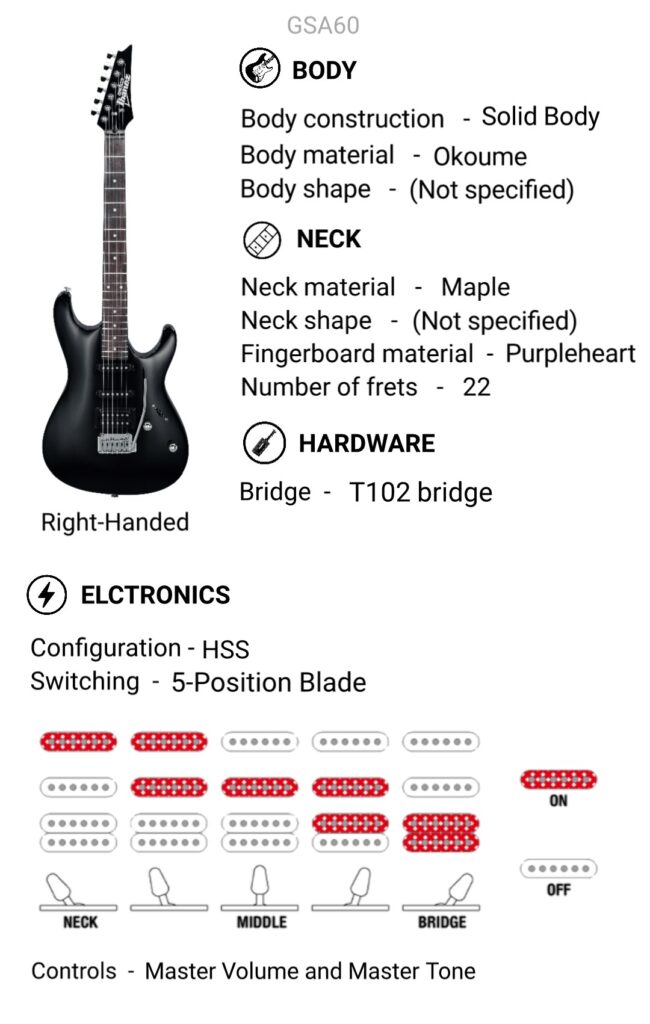
Ibanez GRG170DX
Ibanez GRG120QASP
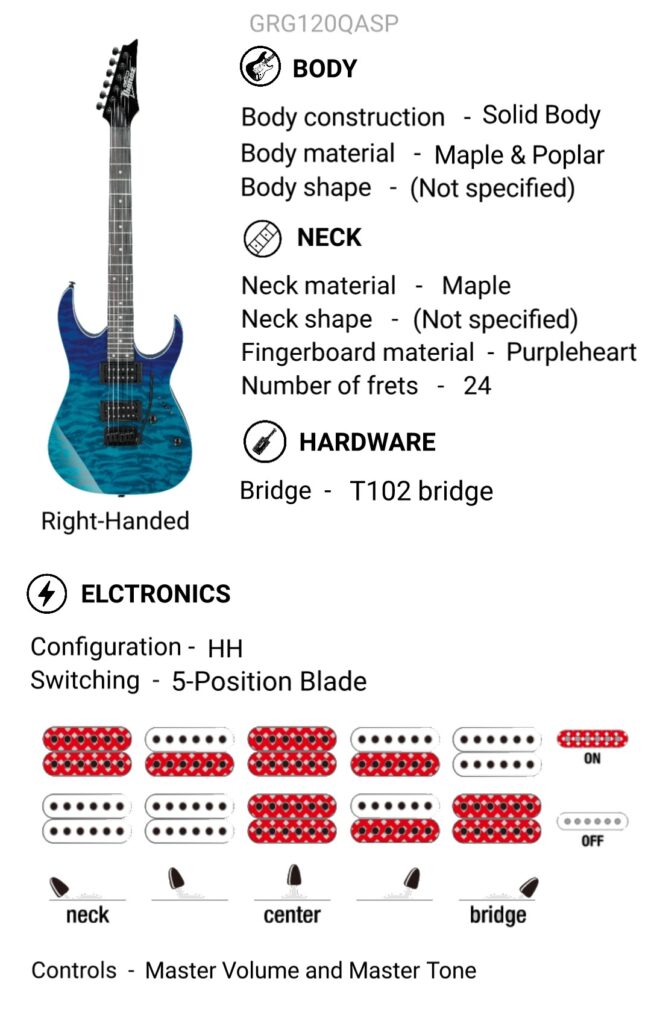
Ibanez GRG220PA1
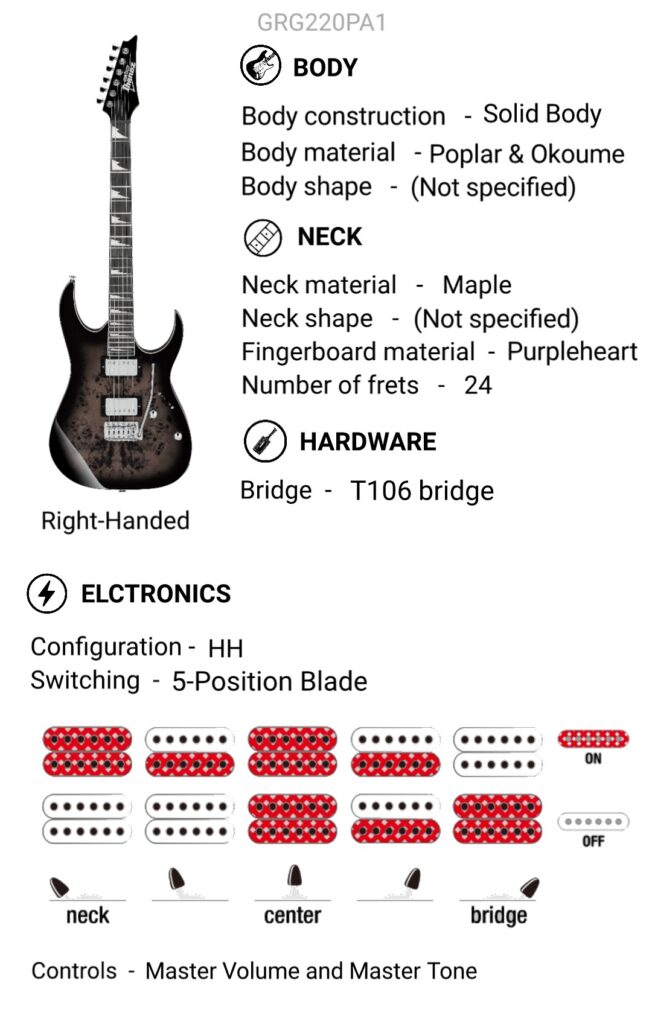
Ibanez S521
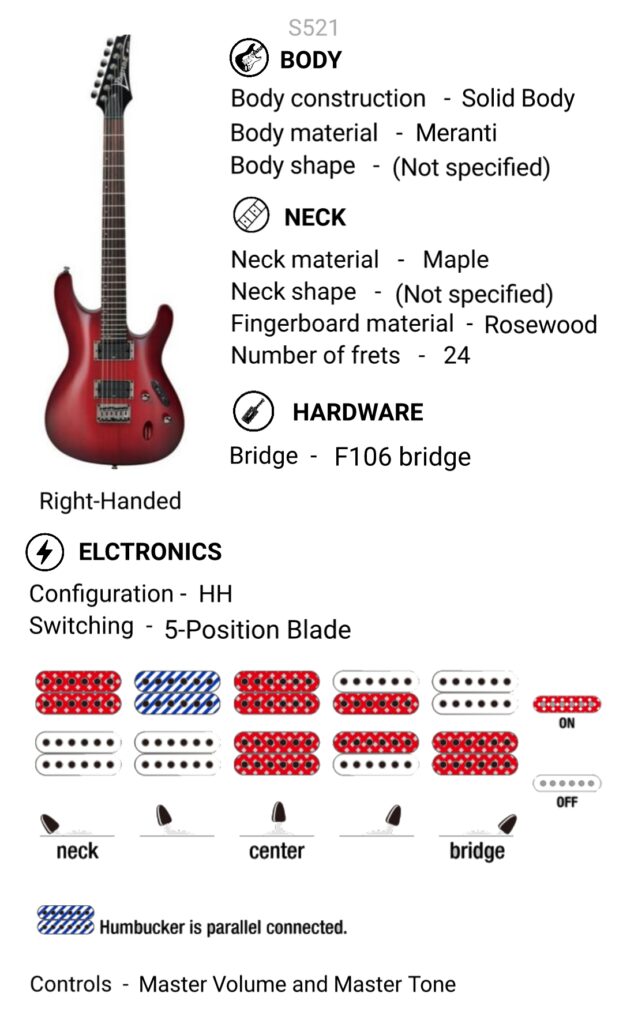
Ibanez SA260FM
Ibanez RGRT421

Ibanez AR420
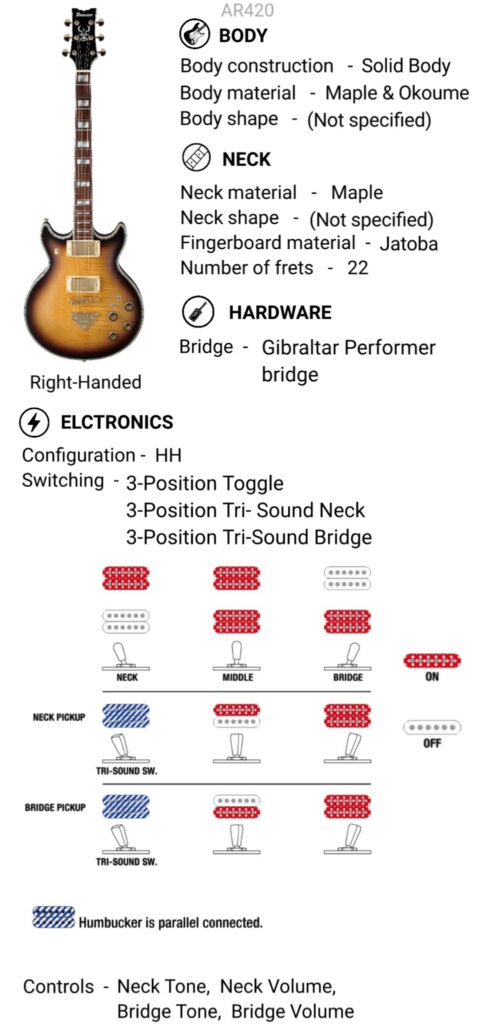
Introduction: Ibanez electric guitars have carved a distinct niche in the music world, celebrated for their innovative designs, versatility, and commitment to meeting the demands of players across genres. From the legendary RG series to the avant-garde JEM models, Ibanez boasts an extensive lineup that appeals to beginners and virtuosos alike. In this comprehensive guide, we embark on a journey through the diverse world of Ibanez electric guitars, exploring key models and iconic series that have defined the brand.
”Read_More”
1. RG Series:
- The Ibanez RG series is a cornerstone for shred and heavy metal players. Known for sleek, double-cutaway designs, fast necks, and versatile pickups, the RG series includes various models like the RG550, RG Genesis Collection, RG Premium Series, and RG Iron Label Series.
2. S Series:
- The Ibanez S series is celebrated for its slim and sculpted body, offering comfort and playability. Models like the S570AH and S Iron Label Series appeal to players seeking a sleek design with versatile tones.
3. JEM Series:
- The JEM series is a collaboration with virtuoso Steve Vai, featuring iconic designs such as the JEM7V and more affordable options like the JEMJR. These guitars are known for their unique aesthetics, DiMarzio pickups, and the distinctive “Monkey Grip.”
4. AZ Series:
- The Ibanez AZ series represents a modern approach to the traditional double-cut design. Models like the AZ Prestige Series and AZ Premium Series focus on premium craftsmanship, versatility, and innovative features.
5. Signature Models:
- Ibanez collaborates with renowned artists to produce signature models tailored to their playing styles. Signature series include guitars for artists like Paul Gilbert (PGM Series), Joe Satriani (JS Series), Steve Vai (JEM Series), and Tosin Abasi (TAM Series).
6. RG Axion Label Series:
- The RG Axion Label series features guitars with advanced features like extended range options and high-performance specifications. These guitars are designed for modern players looking for cutting-edge design and playability.
7. GRG Series:
- The GRG series offers affordable options for players on a budget. Models like the GRG121DX and GRX Series provide a gateway to the Ibanez brand with quality features for beginners.
8. Artcore Series:
- The Artcore series is Ibanez’s line of semi-hollow and hollow-body guitars, catering to jazz and blues players. The series includes different lines such as Artcore Expressionist, Artcore Vintage, and Artcore AS Series.
9. AR Series:
- The AR series, represented by the AR Standard Series, features classic double-cutaway designs with a focus on simplicity and elegance. These guitars often appeal to players looking for a vintage aesthetic.
10. FR Series:
- The FR series, including the FR Prestige Series and FR Iron Label Series, is designed for players who prefer a modern, ergonomic shape. These guitars often feature high-performance specifications for heavy genres.
11. RGD Series:
- The RGD series, including the RGD Prestige Series and RGD Iron Label Series, is tailored for extended-range players. These guitars often feature multi-scale designs and high-output pickups for modern metal tones.
12. Talman Series:
- The Talman series, including the Talman Prestige Series and Talman Standard Series, offers a blend of vintage aesthetics and modern playability. These guitars are versatile and suitable for various styles.
13. Axion Label Series:
- The Axion Label series encompasses a range of models, including the RG Axion Label, S Axion Label, and RGD Axion Label. These guitars feature innovative designs, high-performance specs, and extended range options.
14. RG RGA Series:
- The RG RGA series, represented by the RG RGA Standard Series, combines the features of the RG and RGA lines, offering a balance between modern design and traditional playability.
15. AT Series:
- The AT series, including the AT Prestige Series, is a collaboration with guitarist Andy Timmons. These guitars are designed to meet Timmons’ specific tonal and playability preferences.
16. Joe Satriani JS Series:
- The Joe Satriani JS series, including JS Prestige Series and JS Standard Series, is tailored to the specifications of guitarist Joe Satriani. These guitars offer versatile tones and unique design features.
17. RG Standard Series:
- The RG Standard series features various models, including the RG550XH 9-String. These guitars offer the RG series’ essential features at a standard level, providing accessibility to a wide range of players.
18. RG Axion Label RGD Series:
- The RG Axion Label RGD series, represented by models like the RG Axion Label RGD71ALMS, focuses on extended-range guitars with ergonomic designs and high-performance features.
19. RG Axion Label S Series:
- The RG Axion Label S series, including the RG Axion Label S671ALB, combines the features of the RG and S lines, offering slim bodies, fast necks, and modern features.
20. GRGM Series:
- The GRGM series, including the GRGM21M, offers compact and affordable options suitable for younger players or those seeking a smaller-scale guitar.
21. GIO Series:
- The GIO series includes budget-friendly options across various Ibanez lines, such as GIO RG Series, GIO S Series, and GIO GRG Series. These guitars provide accessible entry points for beginners.
How to choose right ibanez electric Guitar
Choosing the right Ibanez electric guitar involves considering various factors that align with your playing style, preferences, and budget. Ibanez offers a diverse range of models across different series, so finding the perfect guitar involves a thoughtful exploration of the options available. Here’s a guide to help you choose the right Ibanez electric guitar:
1. Define Your Budget:
- Ibanez offers guitars across a wide price spectrum. Determine your budget to narrow down your options and focus on guitars within your financial range.
2. Identify Your Playing Style:
- Different Ibanez series cater to various playing styles, from shred and metal to jazz and rock. Consider the genre or genres you primarily play, as this will influence the type of pickups, neck profiles, and tonal characteristics you’ll want in your guitar.
3. Choose the Right Series:
- Ibanez offers several series, each with its own unique features. Explore series like the RG, S, JEM, AZ, and more. Each series may have specific design elements and tonal characteristics that suit different playing styles.
4. Pickup Configurations:
- Ibanez guitars come with various pickup configurations, including HSS, HH, and HSH setups. Consider the type of tones you want and whether you prefer the versatility of multiple pickups or a simpler setup.
5. Neck Profile and Scale Length:
- Ibanez is known for its fast and slim neck profiles. Consider the neck shape (Wizard, Super Wizard, etc.) and scale length based on your comfort and playing preferences.
6. Bridge Type:
- Ibanez guitars often feature different bridge types, such as fixed bridges, tremolos, or double-locking systems. Choose a bridge type that suits your playing style and tuning stability preferences.
7. Tonewoods:
- Consider the tonewoods used in the construction of the guitar. Mahogany and basswood are common body woods, while maple and roasted maple are often used for necks. Different tonewood combinations affect the guitar’s overall tone.
8. Aesthetics and Finishes:
- Ibanez guitars are known for their stylish designs and vibrant finishes. Choose a guitar that appeals to you visually, whether it’s a classic solid color, a flamed maple top, or a unique finish from a signature model.
9. Signature Models:
- If you’re a fan of a particular artist, explore Ibanez signature models. Artists like Steve Vai, Joe Satriani, and Paul Gilbert have signature guitars with unique features tailored to their playing styles.
10. Explore Reviews and Demos:
- Read reviews and watch video demos of the Ibanez guitars you’re interested in. This will provide insights into the real-world experiences of other players and help you understand how each model sounds and performs.
11. Playability and Comfort:
- Playability is crucial for an enjoyable playing experience. If possible, play the guitar before making a purchase. Pay attention to the feel of the neck, fretwork, and overall comfort.
12. Consider Used Options:
- If your budget allows, consider looking into the used market. Used Ibanez guitars can offer excellent value for money, and you might find a gem that fits your requirements.
Choosing the right Ibanez electric guitar is a personal journey that depends on your unique preferences and playing style. Whether you’re drawn to the high-performance RG series, the versatile AZ series, or the artistic JEM series, Ibanez provides a broad range of options to suit musicians of all levels and tastes.
Pros and Cons of ibanez electric Guitar
Ibanez electric guitars are renowned for their innovative designs, versatile tones, and playability. However, like any brand, they have both strengths and weaknesses. Here’s an overview of the pros and cons of Ibanez electric guitars:
Pros of Ibanez Electric Guitars:
- Innovative Designs:
- Ibanez is known for pushing the boundaries of guitar design, introducing unique features and shapes that appeal to players seeking something different.
- Versatility:
- Ibanez guitars are versatile and cater to a wide range of playing styles, from rock and metal to jazz and blues. Different series offer various tonal options to suit diverse genres.
- Fast and Slim Necks:
- Ibanez is celebrated for its fast and slim neck profiles, such as the Wizard neck. This facilitates comfortable and quick playing, especially for those who prefer shredding or intricate lead work.
- Wide Range of Series:
- Ibanez offers various series, including the RG, S, JEM, AZ, and more, each with its own unique features. This variety allows players to find a guitar that matches their preferences.
- Signature Models:
- Ibanez collaborates with renowned artists to produce signature models that cater to specific playing styles. These models often feature unique specs and aesthetics.
- Quality Construction:
- Ibanez guitars are generally well-built with attention to detail. The brand is known for delivering quality instruments at various price points.
- Value for Money:
- Ibanez offers guitars across a wide price range, providing options for players with different budgets. Many Ibanez models offer excellent value for money.
- Extended Range Guitars:
- Ibanez is a pioneer in the production of extended-range guitars, including 7-string and 8-string models, catering to players who explore lower tunings and heavier genres.
Cons of Ibanez Electric Guitars:
- Limited Tonal Palette for Traditional Styles:
- While Ibanez is versatile, some players argue that certain models may not capture the traditional tones associated with classic styles like blues or vintage rock.
- Thin Body Construction:
- Some players prefer thicker-bodied guitars for a more resonant tone. Ibanez, especially in certain series, tends to offer thinner body constructions, which may not suit everyone’s preference.
- Not Ideal for Traditionalists:
- Traditionalists who appreciate vintage-style instruments may find Ibanez’s modern and innovative designs less appealing.
- Less Focus on Traditional Finishes:
- Ibanez is known for bold and contemporary finishes, but players seeking classic sunburst or vintage finishes may have limited options.
- Aggressive Aesthetics:
- Some players may find the aggressive and modern aesthetics of certain Ibanez models less suitable for their personal taste.
- Consistency in Quality Control:
- While the overall quality of Ibanez guitars is generally high, there have been occasional reports of inconsistency in quality control across different production batches.
In conclusion, Ibanez electric guitars are favored by many players for their modern designs, playability, and versatility. The cons are often subjective and depend on individual preferences. Whether you’re drawn to the sleek RG series, the artistic JEM models, or the versatile AZ series, Ibanez offers a diverse lineup that caters to a wide range of musicians.
History of Ibanez electric Guitar
The history of Ibanez electric guitars dates back to the early 20th century. The company originated in Japan and has evolved over the years into a prominent player in the guitar industry. Here’s a concise overview of the history of Ibanez electric guitars:
Early Years:
- 1908: The company that would eventually become Ibanez started as the Hoshino Gakki company in Nagoya, Japan. Initially, it focused on the production of musical instruments, including Spanish-style acoustic guitars.
Post-World War II:
- 1935: Hoshino Gakki expanded into the importation of Spanish guitars from Salvador Ibáñez, a Spanish luthier. They started using the Ibanez brand name for these imported guitars.
1950s-1960s:
- 1957: Hoshino Gakki began producing its own guitars under the Ibanez name.
- Late 1950s – Early 1960s: The company gained attention by producing high-quality copies of popular American guitars, especially from Gibson and Fender. These guitars were often sold in Japan.
- 1962: Hoshino Gakki started exporting guitars to the United States.
- 1966: The Tama brand was established for drum production under Hoshino Gakki.
1970s:
- Early 1970s: Ibanez continued producing copies of American guitars, gaining a reputation for producing affordable yet high-quality alternatives.
- 1971: Hoshino Gakki officially registered the Ibanez brand in the United States.
- Mid-1970s: Ibanez introduced original designs, such as the Iceman and the Artist series, which helped establish the brand as more than just a copycat manufacturer.
- 1975: The introduction of the Ibanez “lawsuit era” guitars, highly accurate replicas of popular American models, further boosted the brand’s visibility.
1980s:
- 1980s: Ibanez gained recognition for its innovative and high-performance guitars, particularly in the rock and metal genres.
- 1987: The Ibanez JEM series, developed in collaboration with Steve Vai, was introduced, featuring unique designs and features tailored to Vai’s specifications.
- 1987: The RG series, known for its fast necks and aggressive designs, became a staple for metal players.
1990s-2000s:
- 1990s: Ibanez continued to expand its lineup, introducing various signature models for prominent guitarists and exploring extended-range guitars.
- Late 1990s: The introduction of the S series, known for its slim and contoured body, added versatility to Ibanez’s offerings.
- 2000s: Ibanez strengthened its position in the metal market with models like the RG Prestige series and the 7-string Universe, also developed in collaboration with Steve Vai.
2010s-Present:
- 2010s: Ibanez continued to innovate, introducing models with cutting-edge features, extended-range options, and collaborations with contemporary artists.
- Present: Ibanez remains a leading brand, offering a diverse range of electric guitars across various series, including the RG, S, AZ, JEM, and more.
Ibanez has successfully navigated its journey from being known for replicas to establishing itself as a brand associated with innovation, quality, and a wide range of options for players across different genres and skill levels. The company’s commitment to craftsmanship and responsiveness to the evolving needs of musicians have contributed to its enduring popularity in the guitar industry.
”Read_Less”


